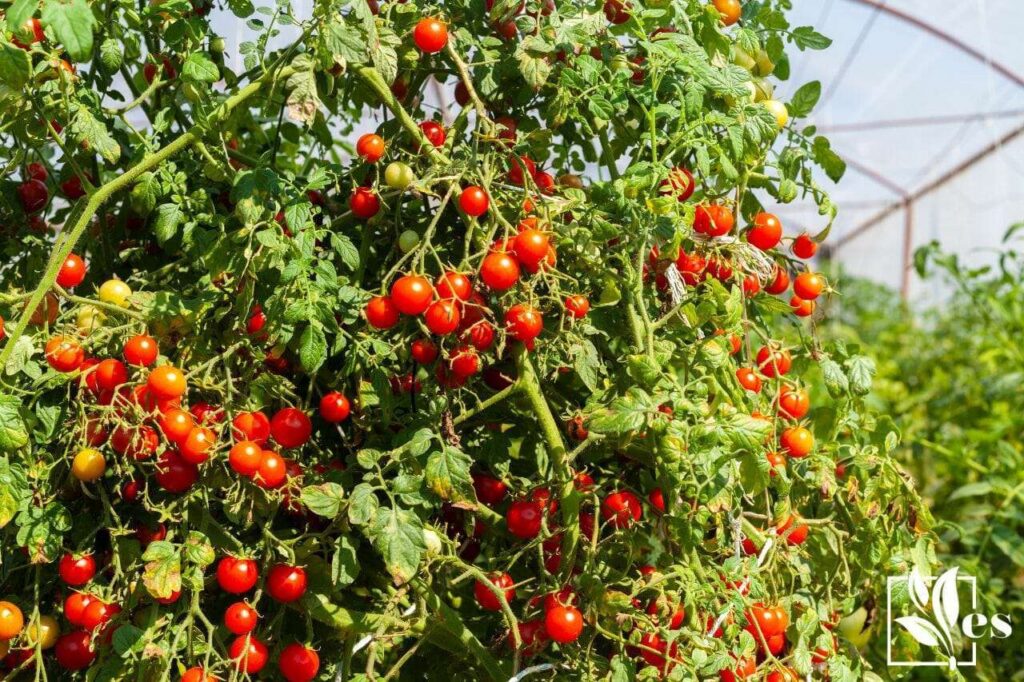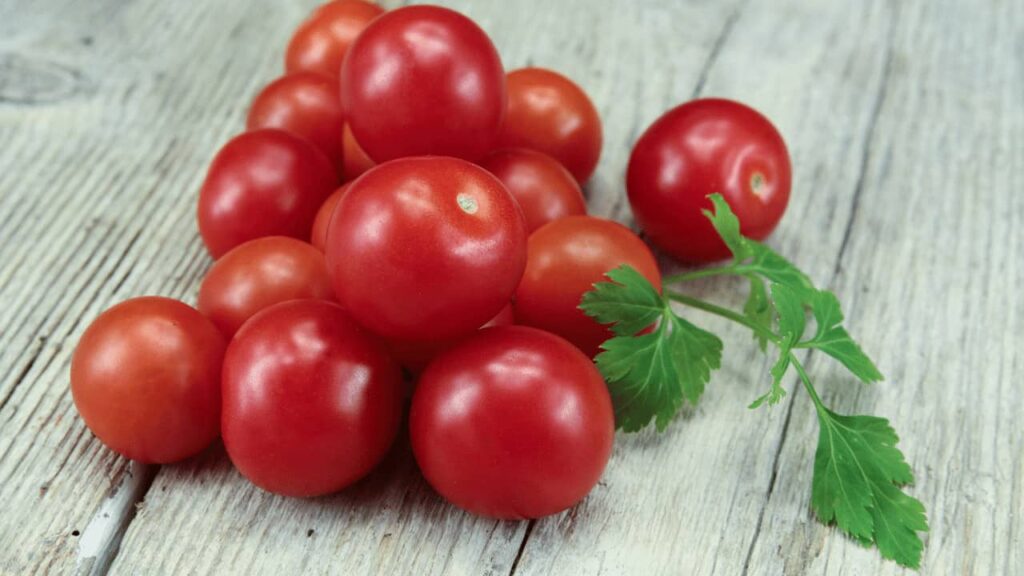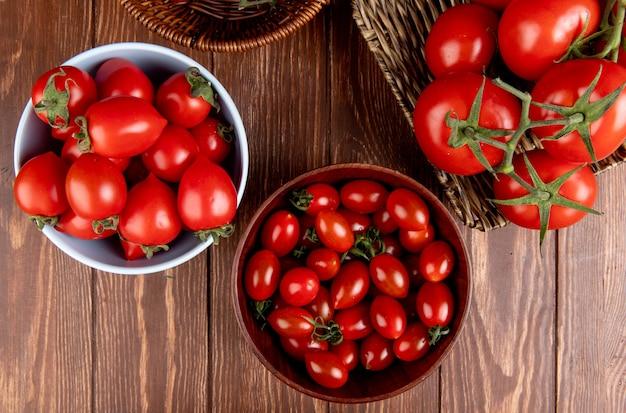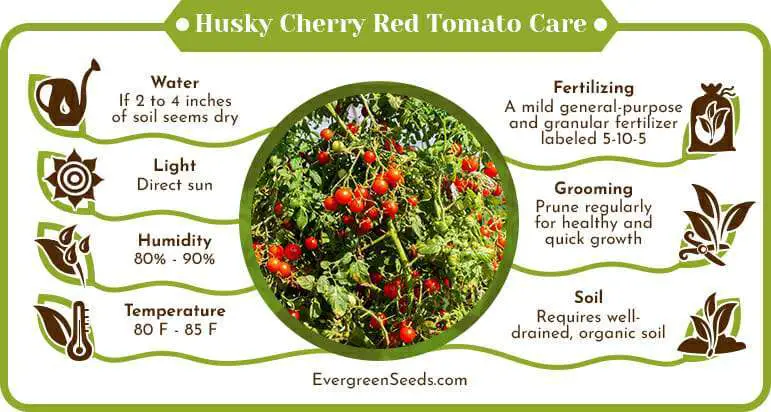So, you’ve decided to venture into the world of gardening and want to learn how to grow delicious husky cherry red tomatoes. Well, you’re in luck! This ultimate guide will provide you with all the tips and tricks you need to successfully cultivate these vibrant and flavorful tomatoes in your own backyard. From selecting the right variety of seeds to ensuring proper soil conditions and providing adequate care, this article will walk you through each step of the process, helping you achieve a bountiful harvest of juicy tomatoes that will surely impress your friends and family.

Choosing the Right Location
Sunlight Requirements
When choosing the perfect location for your husky cherry red tomatoes, it’s crucial to consider their sunlight requirements. These tomatoes thrive in full sun, which means they need at least 6-8 hours of direct sunlight each day. Look for a spot in your garden that receives the most sunlight throughout the day. Keep in mind that insufficient sunlight can lead to weak and straggly plants, poor fruit production, and increased susceptibility to diseases.
Soil Requirements
The quality of the soil plays a vital role in the success of your tomato plants. Husky cherry red tomatoes prefer well-draining soil that is rich in organic matter. Before planting, test the pH of your soil to ensure it falls within the ideal range of 6.0 to 6.8. This slightly acidic to neutral soil pH encourages nutrient availability, optimal growth, and prevents nutrient deficiencies. You can use a soil testing kit or send a soil sample to a local agricultural extension office for analysis.
Preparing the Soil
Testing the Soil
Testing your soil before planting your husky cherry red tomatoes is crucial for understanding its composition and nutrient levels. A soil test will provide valuable information about the pH, nutrient content, and organic matter present in your soil. By conducting a soil test, you can identify any deficiencies or imbalances and make informed decisions regarding soil amendments and fertilizers. Follow the instructions provided with your soil testing kit or consult with your local agricultural extension office for professional soil testing services.
Amending the Soil
To ensure your husky cherry red tomatoes have the best possible start, it’s essential to amend your soil if needed. If the pH of your soil is too high or low, you can adjust it by adding lime or sulfur accordingly. Additionally, incorporating organic matter such as compost, well-rotted manure, or aged leaf mold into the soil improves its structure, drainage, and nutrient-holding capacity. Work the amendments into the top 6-8 inches of soil, ensuring they are evenly distributed.
Adding Organic Matter
Adding organic matter is an excellent way to enrich your soil and provide essential nutrients for your husky cherry red tomato plants. Organic matter helps retain moisture, improves soil structure, and enhances microbial activity. You can add compost, well-rotted manure, or other organic materials to the soil before planting. Spread a layer of organic matter over the top of the soil and work it in using a garden fork or tiller. Aim for a depth of 4-6 inches to ensure thorough incorporation.

Starting Seeds Indoors
Understanding the Planting Calendar
When starting your husky cherry red tomato plants from seeds indoors, it’s crucial to understand your local planting calendar. The planting calendar provides information on when to start seeds indoors, the ideal time for transplanting seedlings, and the estimated harvest date. Consult your local agricultural extension office or gardening resources specific to your region to determine the appropriate planting dates. Following the planting calendar ensures your tomato plants have ample time to grow and produce fruit during the optimal growing season.
Selecting Quality Seeds
Choosing high-quality seeds is essential for successful germination and healthy plants. Look for reputable seed suppliers that offer husky cherry red tomato seeds. Select seeds that are fresh, dark, plump, and preferably organic. Keep in mind that different varieties of husky cherry red tomatoes may have slightly different characteristics, so choose the variety that best suits your preferences and growing conditions.
Creating Seedling Trays
Before sowing the seeds, you’ll need to prepare seedling trays or containers to provide a suitable environment for germination and seedling growth. Use clean trays or pots filled with a well-draining seed-starting mix. Ensure the containers have drainage holes to prevent waterlogging. Fill the trays with the seed-starting mix, leaving about half an inch of space at the top to allow for watering. Gently pat down the mix to create a firm but not compacted surface.
Sowing the Seeds
Once your trays or containers are ready, it’s time to sow the husky cherry red tomato seeds. Follow the instructions provided on the seed packet for the appropriate spacing and planting depth. As a general guideline, plant the seeds about a quarter to half an inch deep. Place one or two seeds in each cell or small pot. Lightly cover the seeds with the seed-starting mix and mist the surface with water to ensure good moisture contact.
Providing Adequate Light and Temperature
Proper lighting and temperature are crucial for seed germination and healthy seedling development. Place the trays in a warm area with temperatures between 70-80°F (21-27°C) for optimal germination. Once the seeds have sprouted, move them to a well-lit location that receives at least 12-14 hours of bright, indirect light each day. If natural light is insufficient, you can use fluorescent lights or grow lights positioned a few inches above the seedlings to provide adequate light intensity.
Transplanting Seedlings
Hardening Off
Before transplanting your husky cherry red tomato seedlings outdoors, it’s essential to gradually expose them to outdoor conditions in a process called hardening off. This gradual acclimation helps the young plants adapt to environmental changes such as fluctuating temperatures, increased sunlight, and wind. About a week before transplanting, start by placing the seedlings outside for a few hours a day in a sheltered location. Gradually increase the duration and exposure to outdoor conditions until the seedlings are ready for full-time outdoor planting.
Choosing the Right Time
Choosing the right time to transplant your seedlings is crucial for their successful growth and productivity. Wait until the danger of frost has passed and the soil has warmed up to a consistent temperature of 60°F (15°C) or higher. While husky cherry red tomatoes are relatively tolerant of cooler temperatures, transplanting them into cold soil or exposing them to frost can stunt their growth and cause long-term damage.
Preparing the Seedlings
Before transplanting, prepare your husky cherry red tomato seedlings for their new home. Gently remove them from their trays or pots, being careful not to damage the delicate roots. If the seedlings have become root-bound, untangle or loosen the roots slightly to encourage healthy growth. Trim off any damaged or excessively long roots. Handle the seedlings by their leaves or root ball, avoiding direct contact with stems to prevent damage.
Transplanting into Containers or Beds
When transplanting your husky cherry red tomato seedlings, choose between containers or garden beds based on your available space, preference, and gardening methods. If planting in containers, ensure they have adequate drainage holes and are filled with well-draining potting mix. Dig a hole in the soil or potting mix slightly larger than the root ball of the seedling. Place the seedling in the hole, backfill with soil, and gently firm the soil around the base of the plant. Ensure that the top of the root ball is level with the surrounding soil and water thoroughly.

Staking and Supporting the Plants
Determining the Support Method
Proper support is necessary to prevent your husky cherry red tomato plants from sprawling on the ground, which can lead to fruit rot, disease, and pests. There are various methods to support tomato plants, including staking, caging, and trellising. Consider the size and growth habit of your husky cherry red tomatoes when selecting a support method. Indeterminate varieties that continue to grow throughout the season usually benefit from sturdy stakes or trellises, while determinate varieties may thrive in cages.
Installing Stakes or Cages
If you choose to stake or cage your husky cherry red tomato plants, install the supports early in the growing season to avoid damaging the roots or disturbing the plants later. For staking, insert a sturdy stake into the ground near the base of each plant, ensuring it is at least 6 feet tall and deeply driven into the soil. Gently tie the main stem of the tomato plant to the stake using soft twine or plant ties, allowing room for growth and airflow. For caging, place a wire cage around each plant, ensuring it is tall enough to accommodate the mature height of the plant.
Pruning the Plants
Pruning your husky cherry red tomato plants is an optional technique that can help improve airflow, increase sunlight penetration, and promote fruit ripening. Pruning involves selectively removing suckers, which are the small shoots that grow between the main stem and the leaf branch junctions. By removing suckers, you direct the plant’s energy towards fruit production rather than excessive foliage growth. Use clean, sharp pruning shears to make clean cuts, and avoid removing more than necessary to maintain plant vigor.
Watering and Fertilizing
Establishing a Watering Schedule
Proper watering is essential for the health and productivity of your husky cherry red tomato plants. Aim to keep the soil consistently moist but not waterlogged. Erratic watering can lead to issues like split fruit, blossom end rot, and uneven fruit development. Establish a watering schedule based on the weather conditions, plant size, and soil moisture levels. Water deeply, ensuring the soil is saturated to a depth of 6-8 inches. As a general guideline, tomato plants typically require watering every 2-3 days during hot, dry periods.
Avoiding Overwatering
While it’s crucial to provide adequate moisture, overwatering your husky cherry red tomato plants can cause root rot, fungal diseases, and decrease fruit quality. To avoid overwatering, monitor the soil moisture levels by inserting your finger or a moisture meter into the soil. Water only when the top few inches of soil feel dry to the touch. Additionally, ensure proper drainage by incorporating organic matter, using well-draining containers or raised beds, and avoiding excessive watering during periods of heavy rain.
Applying Organic Fertilizers
Proper fertilization helps provide essential nutrients for your husky cherry red tomatoes, promoting healthy growth and abundant fruit production. Organic fertilizers are an excellent choice as they release nutrients gradually, improve soil fertility, and support beneficial soil organisms. Apply a balanced organic fertilizer, such as compost or well-rotted manure, before planting, incorporating it into the soil. As the plants grow, side-dress them with additional organic fertilizer every 4-6 weeks or as recommended by the product instructions.

Controlling Pests and Diseases
Identifying Common Tomato Pests
To protect your husky cherry red tomato plants from pests, it’s essential to identify common tomato pests and implement appropriate control methods. Common tomato pests include aphids, tomato hornworms, whiteflies, and flea beetles. Keep a close eye on your plants and inspect them regularly for any signs of pest activity, such as chewed leaves, discoloration, or stunted growth. Identifying the pests correctly allows you to choose the most effective natural control methods and minimize damage to your plants.
Using Natural Pest Control Methods
For an organic approach to pest control, there are several natural methods you can employ to protect your husky cherry red tomato plants. One effective method is handpicking pests off the plants and dropping them into a bucket of soapy water. Introducing beneficial insects such as ladybugs or lacewings can help control aphid populations. Neem oil, insecticidal soaps, or homemade garlic and chili pepper sprays can also be used to repel or kill pests. Additionally, practicing proper garden hygiene by removing debris and weeds helps reduce pest habitats.
Preventing Diseases
Preventing diseases is crucial for the health and productivity of your husky cherry red tomato plants. To minimize disease incidence, follow good gardening practices such as avoiding overhead watering, providing adequate spacing between plants for airflow, and practicing crop rotation. Additionally, remove any infected or diseased plant material promptly to prevent the spread of pathogens. Consider using disease-resistant varieties and applying organic fungicides or biological controls if necessary.
Pruning and Training the Plants
Understanding Pruning Techniques
Pruning plays an essential role in maintaining the health, shape, and productivity of your husky cherry red tomato plants. Understanding the basics of pruning techniques helps you make informed decisions on how and when to prune. The two primary pruning methods for tomatoes are determinate pruning and indeterminate pruning. Determinate varieties typically require minimal pruning, while indeterminate varieties benefit from regular pruning to manage plant size, improve fruit quality, and increase airflow.
Removing Suckers
Suckers are small shoots that emerge from the leaf axils of tomato plants. While removing all suckers is not necessary, it can help maintain better structure, manage plant size, and direct energy towards fruit production. To remove suckers, look for the shoots that grow between the main stem and the leaf branch junctions. Pinch them off with your fingers or use clean pruning shears, ensuring you do not damage the main stem or other branches.
Training the Main Stem
Training the main stem of your husky cherry red tomato plants helps promote upward growth, reduce congestion, and maximize fruit production. The main stem is the central part of the plant that supports the branches and fruits. As the plant grows, gently tie the main stem to the stake or trellis you installed earlier using soft twine or plant ties. This keeps the main stem upright and prevents it from falling or bending under the weight of the branches and fruits. Regularly inspect and adjust the ties as the plants grow taller.

Harvesting and Storing the Tomatoes
Determining Ripeness
Harvesting your husky cherry red tomatoes at the right time ensures maximum flavor, quality, and storage life. Determining ripeness depends on the tomato variety and your personal preferences. Typically, husky cherry red tomatoes are ready for harvest when they have reached their mature size, firm but not hard, and have developed a vibrant red color. Gently squeeze the tomatoes – they should yield slightly to gentle pressure without being too soft or mushy.
Harvesting Techniques
To harvest your husky cherry red tomatoes without damaging the plants, use the proper techniques. Hold the fruit with one hand and use sharp pruning shears or a knife to cut the stem about ¼ inch above the fruit. Avoid pulling or twisting the tomatoes, as this can damage the stems and potentially lead to the spread of diseases. Place the harvested tomatoes in a shallow basket or tray to prevent bruising and ensure good air circulation.
Storing and Preserving the Tomatoes
Proper storage and preservation techniques help prolong the shelf life and maintain the flavors of your freshly harvested husky cherry red tomatoes. If you plan to use them within a few days, store the ripe tomatoes at room temperature away from direct sunlight. Avoid refrigerating fully ripe tomatoes, as cold temperatures can adversely affect their flavor and texture. For long-term storage, select only unblemished, ripe tomatoes and place them in a cool location, such as a basement or pantry.
Common Problems and Troubleshooting
Blossom End Rot
Blossom end rot is a common problem affecting tomato plants, characterized by dark, sunken lesions at the blossom end of the fruit. It is caused by calcium deficiency or inadequate calcium uptake by the plant. To prevent blossom end rot, maintain consistent soil moisture levels, ensure proper calcium availability through soil amendments or foliar sprays, and avoid excessive nitrogen fertilization.
Cracking
Cracking or splitting of husky cherry red tomatoes occurs when the fruit expands faster than the skin can stretch, often due to fluctuating soil moisture levels. To minimize cracking, provide consistent and even moisture by following a regular watering schedule. Mulching around the plants helps maintain soil moisture levels. If the tomatoes have already cracked, harvest them immediately to prevent rot and fungal infections.
Yellowing Leaves
Yellowing leaves on your husky cherry red tomato plants can be an indication of various problems, including nutrient deficiencies, overwatering, or pest and disease issues. Monitor your plants closely and investigate the possible causes. Adjust watering practices, address nutrient imbalances through appropriate fertilization, and promptly address any pest or disease problems to prevent further yellowing and damage to the plants.
By following these comprehensive guidelines, you can successfully grow and enjoy the flavorful and juicy husky cherry red tomatoes in your own garden. Remember to adapt the instructions to your specific location and growing conditions, and always observe your plants closely for any signs of distress or issues. Happy tomato growing!



